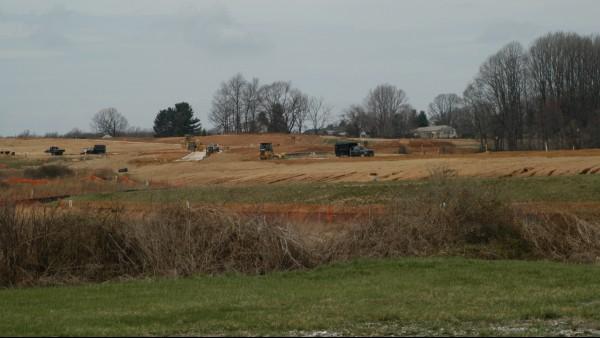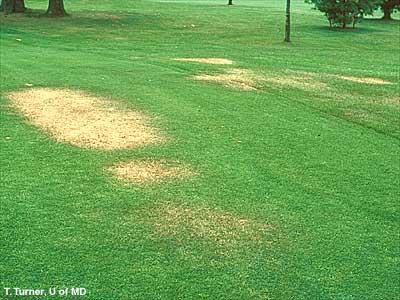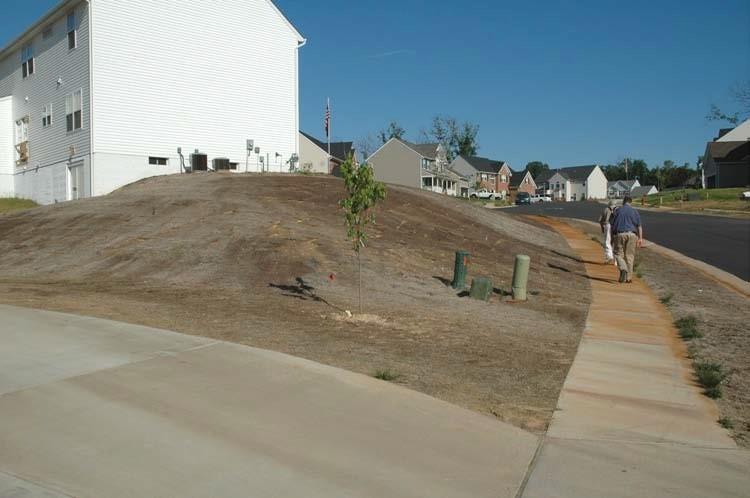Key points about soil issues
- Plant problems and poor growth (whether turfgrass, shrubs, vegetables, fruit, or flowers) may be caused, in part, by one or more soil problems.
- Soil compaction (dense soil that drains water very slowly), topsoil removal, and erosion are three key soil problems.
- Evaluating your soil and making necessary adjustments and improvements prior to planting will save you time and money and result in a healthier landscape. It’s difficult to go back and correct poor soil once an area is planted.
- Fertilizing plants that are growing poorly, or are in decline, will only help if the symptoms are actually caused by low nutrient levels in the soil. Test your soil before fertilizing if you suspect low soil fertility
No topsoil /low organic matter
- Topsoil is the first 4-8 inches of soil and contains most of the organic matter, plant roots, and microbial and animal life.
- Soils have been significantly altered in urban and suburban areas. Topsoil is typically removed during construction, soil layers (known as horizons) are inverted or mixed, and low-quality fill dirt is often added.
- Topsoil that is not protected and/or is on sloped ground is vulnerable to washing away in storms (erosion).

Management
- Mixing compost into the top six inches of soil, prior to planting, or applying it to the top of perennial and shrub beds (1 inch annually) will improve soil structure and plant growth. More information can be found on this page Organic Matter and Soil Amendments.
- Buying topsoil. Topsoil sales are not regulated in Maryland. If you plan to buy topsoil in bulk, go to a reputable nursery or topsoil dealer and ask for soil test results and information on the origin of the soil and on-site mixing and storage. Refer to this page for more information Soil to Fill Raised Beds.
Heavy (clay) soil/compaction/poor drainage
- When irrigation water or rainfall quickly penetrates through a soil we say that it’s well-drained. Poorly drained soils are often high in clay, in low-lying areas, or compacted.
- Soils have poor drainage when rainfall or irrigation water cannot easily enter (infiltrate) or move downward through the soil (percolation). Water displaces air in the soil pore spaces depriving roots of oxygen, leading to wilting. In extreme cases, water may pond (sit on top of the ground for days following heavy rainfall) and cause plant death.
- Clay particles attract and hold water, nutrients, and bits of organic matter, but problems may arise when the clay portion of soil solids exceeds one-third. The soil may be sticky when wet and brick-like when dry. It may be difficult to prepare the soil for planting and plants may struggle due to a lack of oxygen and too much or too little water. (Refer to the Soil Basics page for more information.)
- The weight of machinery, vehicles, garden equipment, and humans pushes particles together reducing the size and number of pore spaces and removing air from soil. Clay particles are very small making clayey soils more vulnerable to compaction. Compaction increases bulk density, measured as the dry weight of soil divided by the volume (grams/cubic centimeters).
- Soil compaction results in poor root growth and plant establishment, drowned roots, root and crown rots, and increased acidity.
- High clay content and compaction are often cofactors in slow drainage. Another cause is hardpans, compacted soil layers impervious to water, air, and nutrients that can occur at any depth. Soils that are bare or where nothing grows often suffer from compaction and poor water drainage.
Quick tests for drainage and compaction
- When soil is moist but not wet (a few days after a rain) you should be able to push a stiff steel wire about 12 inches into the soil without the wire bending.
- Test for soil drainage (percolation): Dig a hole 12 inches deep and about 12 inches in diameter. Fill it with water. The next day, fill the hole with water again. All of the water should drain out within eight hours. If the water drains out more than four inches per hour, the soil is probably very sandy. Less than 1 inch per hour is too slow and may indicate soil compaction, a high clay content, buried debris, a high water table, or a restrictive layer of soil.
- A simpler but less precise test: Dig a hole 12 inches deep and 8 inches in diameter. Fill it with water. Fill it again 12 hours later. All the water should drain out within 2-3 hours.
Management
- Loosen and aerate heavy and compacted soils with a garden fork. Push the fork in and gently rock the soil forward and backward. Lift the fork out, move 8-12 inches, and repeat. This can work well in garden beds but may not be practical over large areas.
Loosening subsoil with a garden fork
- To improve soil structure and drainage, increase the soil organic matter level with compost, organic mulches, living plants, and cover crops (vegetable gardens). More information can be found on this page Organic Matter and Soil Amendments.
- Adding fine sand to heavy clay soil in an effort to improve soil structure and drainage can reduce pore space and slow drainage further. In some cases, a large amount (at least 50% by volume) of coarse "builder's sand" can be mixed into the soil in small areas to improve drainage for select plants.
- Gypsum is a mineral that adds two important plant nutrients, calcium and sulfur, without affecting soil pH. But it is not a "clay buster" and will not improve the structure of Maryland soils.
- Plant in raised beds to raise plants above compacted, slow-draining soil. More information can be found on this page: Soil to Fill Raised Beds.
- Sometimes the easiest solution is selecting plants that are adapted to poorly drained soil and can tolerate "wet feet".
- Aerate turfgrass areas periodically.
- Don't dig, cultivate, rototill, or walk on soil when it's wet. Use this field test to determine when it's ok to work with soil: Gather a handful of topsoil in your hand and gently squeeze it into a ball. Bounce it up and down in your hand. If it breaks apart into smaller pieces (aggregates) it is dry enough to work.
- Tree experts use an air-spade to alleviate compaction around mature trees and shrubs.
Erosion/slopes
- Water flowing across soil, especially when bare, carries soil particles and nutrients off-site. This can lead to the build-up of sediment in streams, ponds, rivers, and the Chesapeake Bay that degrades water quality, and disrupts and degrades ecosystems.
- The impact of individual raindrops can destroy soil aggregates which could result in erosion.
- Erosion most often occurs on slopes, bare soil, and near downspouts and other places in the landscape where water rushes onto or overland. Storms and extreme high tides can cause erosion along shorelines.
- Climate change is expected to bring more extreme storms and intense rainfall exacerbating erosion issues. Design and plant now with these future impacts in mind.
Management
- Monitor all areas of your yard for signs of soil erosion. Sometimes stormwater that is not able to soak into soil gets channeled and gathers force and can carry away unprotected soil.
- Keep soil covered at all times using groundcovers (from turf to trees), permanent non-plant cover (mulches), or cover crops.
Rocks, buried debris, obstructions

- Buried materials can prevent normal plant growth. This sometimes occurs in lawns that show persistent dead areas. Explore small areas where “nothing seems to grow well” with a shovel to look for and remove rocks, pieces of plywood, etc.
Incorrect soil pH/low nutrient levels
- Soil nutrient levels and soil pH can vary greatly and determine, in large part, nutrient availability and plant growth. Basic soil tests conducted for home gardeners by soil testing labs measure soil pH and the levels of important nutrients. The results sent back to you from the lab include recommendations for raising or lowering soil pH and applying fertilizers.
Lithologic discontinuity (distinct changes in particle size between soil layers)
- This describes the intentional or inadvertent placing of two different soils or growing media next to each other. It occurs during and after building construction and when people add large amounts of compost to planting holes for new trees and shrubs. In the latter case, water is held by the compost and can’t easily move through the adjacent clayey soil, resulting in waterlogged soil, oxygen deprivation, and root death.
- It’s best to either not use compost when planting trees or shrubs or spread and incorporate a 1-2 inch layer of compost over a large area, the eventual root zone.
Soil temperature
- Seeds have optimum soil temperatures and temperature ranges for germination. For example, beans generally won’t germinate and grow well if the soil temperature is less than 60° F or greater than 95° F. Seed germination and root growth can be inhibited or reduced by soil temperature that is too high or low. Large seeds planted in cold spring soil will languish and are subject to attack by soil pathogens, insects, and wildlife.
- Soil temperature affects turf weed germination and weed management. Mowing high and removing small weed infestations by hand are recommended for sustainable management of weeds in turf. If a pre-emergent herbicide is used to control certain weeds, it is critically important to know the best time to apply the product based on soil temperature.
- If using a pre-emergent herbicide to control certain weeds, such as crabgrass, it is critically important to know the best time to apply the product based on soil temperature.
- There is a soil temperature map web page for the U.S. that allows you to get the current soil temperature for your zipcode http://www.greencastonline.com/tools/soil-temperature.* (*Linking to this site does not imply endorsement of any company, manufacturer, or product by University of Maryland Extension.)
Soil contamination
- Many different types of contaminants -- heavy metals like lead, arsenic, and chromium, polycyclic aromatic hydrocarbons (PAHs), pesticides, animal waste, industrial waste -- can find their way into soil. Investigate past land use in situations where contamination is suspected. Check our list of recommended soil testing labs to find those that test for heavy metals.
- Healthy soils with high organic matter content and large and diverse populations of soil microorganisms can tie up heavy metals making them unavailable to plant roots and degrade and inactivate pathogens and contaminants.
- Test vegetable garden soil to determine lead levels.
Author, Jon Traunfeld, HGIC Director and Extension Specialist, Fruits, and Vegetables.
2020
 English
English العربية
العربية Български
Български 简体中文
简体中文 繁體中文
繁體中文 Hrvatski
Hrvatski Čeština
Čeština Dansk
Dansk Nederlands
Nederlands Suomi
Suomi Français
Français Deutsch
Deutsch Ελληνικά
Ελληνικά हिन्दी
हिन्दी Italiano
Italiano 日本語
日本語 한국어
한국어 Norsk bokmål
Norsk bokmål Polski
Polski Português
Português Română
Română Русский
Русский Español
Español Svenska
Svenska Català
Català Filipino
Filipino עִבְרִית
עִבְרִית Bahasa Indonesia
Bahasa Indonesia Latviešu valoda
Latviešu valoda Lietuvių kalba
Lietuvių kalba Српски језик
Српски језик Slovenčina
Slovenčina Slovenščina
Slovenščina Українська
Українська Tiếng Việt
Tiếng Việt Shqip
Shqip Eesti
Eesti Galego
Galego Magyar
Magyar Maltese
Maltese ไทย
ไทย Türkçe
Türkçe فارسی
فارسی Afrikaans
Afrikaans Bahasa Melayu
Bahasa Melayu Kiswahili
Kiswahili Gaeilge
Gaeilge Cymraeg
Cymraeg Беларуская мова
Беларуская мова Íslenska
Íslenska Македонски јазик
Македонски јазик יידיש
יידיש Հայերեն
Հայերեն Azərbaycan dili
Azərbaycan dili Euskara
Euskara ქართული
ქართული Kreyol ayisyen
Kreyol ayisyen اردو
اردو বাংলা
বাংলা Bosanski
Bosanski Cebuano
Cebuano Esperanto
Esperanto ગુજરાતી
ગુજરાતી Harshen Hausa
Harshen Hausa Hmong
Hmong Igbo
Igbo Basa Jawa
Basa Jawa ಕನ್ನಡ
ಕನ್ನಡ ភាសាខ្មែរ
ភាសាខ្មែរ ພາສາລາວ
ພາສາລາວ Latin
Latin Te Reo Māori
Te Reo Māori मराठी
मराठी Монгол
Монгол नेपाली
नेपाली ਪੰਜਾਬੀ
ਪੰਜਾਬੀ Afsoomaali
Afsoomaali தமிழ்
தமிழ் తెలుగు
తెలుగు Yorùbá
Yorùbá Zulu
Zulu ဗမာစာ
ဗမာစာ Chichewa
Chichewa Қазақ тілі
Қазақ тілі Malagasy
Malagasy മലയാളം
മലയാളം සිංහල
සිංහල Sesotho
Sesotho Basa Sunda
Basa Sunda Тоҷикӣ
Тоҷикӣ O‘zbekcha
O‘zbekcha አማርኛ
አማርኛ Corsu
Corsu Ōlelo Hawaiʻi
Ōlelo Hawaiʻi كوردی
كوردی Кыргызча
Кыргызча Lëtzebuergesch
Lëtzebuergesch پښتو
پښتو Samoan
Samoan Gàidhlig
Gàidhlig Shona
Shona سنڌي
سنڌي Frysk
Frysk isiXhosa
isiXhosa